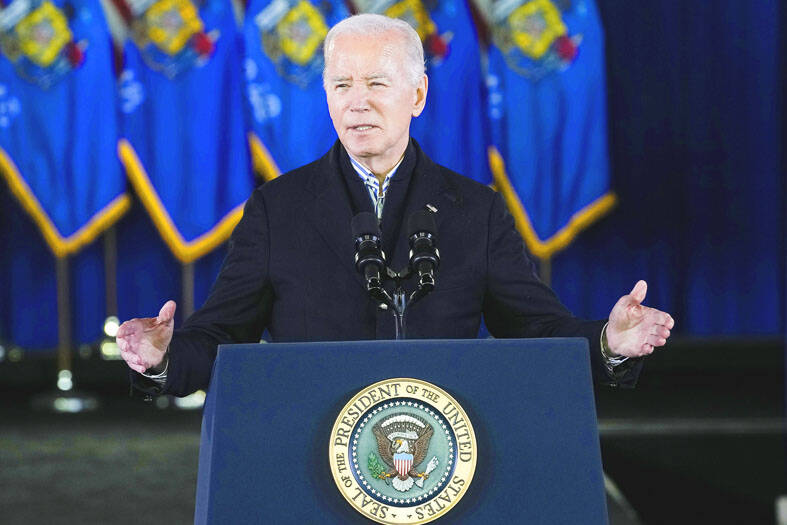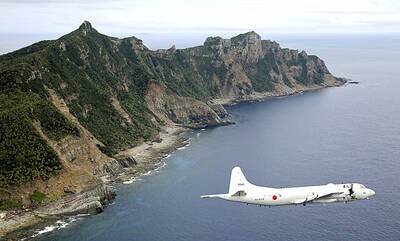US President Joe Biden on Friday signed into law the National Defense Authorization Act (NDAA) for Fiscal Year 2024, which requires the US secretary of defense to create a training program for Taiwan’s military, and requires a status report on the delivery of defensive weapons and services that the US has agreed to sell to Taipei.
Provisions in the NDAA related to Taiwan include measures to help boost its defense capabilities, counter Chinese influence campaigns and support Taiwan’s participation in international organizations.
One of those provisions requires the defense secretary, in consultation with “appropriate officials in Taiwan,” to establish a comprehensive training, advising and institutional capacity-building program for Taiwanese military forces, consistent with the US’ Taiwan Enhanced Resilience Act.

Photo: AP
The NDAA also directs the US secretaries of defense and state to describe actions taken to carry out the program in their annual report to the US Congress.
Other sections in the NDAA require US officials to closely monitor deliveries of defense articles to US allies, including Taiwan, and to prevent delays.
The bill forbids committing more than 85 percent of the funds available to the assistant secretary of the navy for research, development and acquisition until a plan is submitted to provide Harpoon missiles to security partners.
It also requires a briefing on the status of US-provided security assistance to Taiwan before the remaining funds can be released.
Taiwan has committed to purchasing 400 land-launched Harpoon missiles from the US. It hopes to start taking delivery of them in 2026 and to have received all 400 by the end of 2028.
The NDAA requires that the secretaries of defense and state brief congressional committees on the status of US-provided security assistance to Taiwan no later than 180 days after the date of the law’s enactment.
Those reports must include a list of defense articles and services either committed to or planned to be provided to Taiwan, and the estimated delivery schedule for each of them.
Crucially, the NDAA stipulates that the briefing must also identify any defense article or service whose delivery has been delayed by more than three months and the actions taken to prevent delays or accelerate the delivery of such items.
The NDAA also directs the defense secretary to work with Taiwanese officials on cybersecurity activities aimed at defending military networks, infrastructure and systems to counter “malicious cyber activity” aimed at military installations.
It also calls for officials to provide an assessment of the economic impact a potential Chinese invasion would have and response scenarios, along with viable economic policy options that would “cause escalating impacts” on China’s economy “during the pre-conflict phase.”
Officials are also required to provide regular assessments of Chinese efforts to convince Pacific island nations that diplomatically recognize Taiwan to change their allegiance to Beijing.

MISINFORMATION: The generated content tends to adopt China’s official stance, such as ‘Taiwan is currently governed by the Chinese central government,’ the NSB said Five China-developed artificial intelligence (AI) language models exhibit cybersecurity risks and content biases, an inspection conducted by the National Security Bureau (NSB) showed. The five AI tools are: DeepSeek, Doubao (豆包), Yiyan (文心一言), Tongyi (通義千問) and Yuanbao (騰訊元寶), the bureau said, advising people to remain vigilant to protect personal data privacy and corporate business secrets. The NSB said it, in accordance with the National Intelligence Services Act (國家情報工作法), has reviewed international cybersecurity reports and intelligence, and coordinated with the Ministry of Justice Investigation Bureau and the National Police Agency’s Criminal Investigation Bureau to conduct an inspection of China-made AI language

BOOST IN CONFIDENCE: The sale sends a clear message of support for Taiwan and dispels rumors that US President Donald Trump ‘sold out’ the nation, an expert said The US government on Thursday announced a possible sale to Taiwan of fighter jet parts, which was estimated to cost about US$330 million, in a move that an expert said “sends a clear message of support for Taiwan” amid fears that Washington might be wavering in its attitude toward Taipei. It was the first announcement of an arms sale to Taiwan since US President Donald Trump returned to the White House earlier this year. The proposed package includes non-standard components, spare and repair parts, consumables and accessories, as well repair and return support for the F-16, C-130 and Indigenous Defense Fighter aircraft,

CHECKING BOUNDARIES: China wants to disrupt solidarity among democracies and test their red lines, but it is instead pushing nations to become more united, an expert said The US Department of State on Friday expressed deep concern over a Chinese public security agency’s investigation into Legislator Puma Shen (沈伯洋) for “secession.” “China’s actions threaten free speech and erode norms that have underpinned the cross-strait ‘status quo’ for decades,” a US Department of State spokesperson said. The Chongqing Municipal Public Security Bureau late last month listed Shen as “wanted” and launched an investigation into alleged “secession-related” criminal activities, including his founding of the Kuma Academy, a civil defense organization that prepares people for an invasion by China. The spokesperson said that the US was “deeply concerned” about the bureau investigating Shen

DISPUTE: A Chinese official prompted a formal protest from Tokyo by saying that ‘the dirty head that sticks itself out must be cut off,’ after Takaichi’s Taiwan remarks Four armed China Coast Guard vessels yesterday morning sailed through disputed waters controlled by Japan, amid a diplomatic spat following Japanese Prime Minister Sanae Takaichi’s comments on Taiwan. The four ships sailed around the Senkaku Islands — known as the Diaoyutai Islands (釣魚台) to Taiwan, and which Taiwan and China also claim — on Saturday before entering Japanese waters yesterday and left, the Japan Coast Guard said. The China Coast Guard said in a statement that it carried out a “rights enforcement patrol” through the waters and that it was a lawful operation. As of the end of last month,